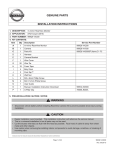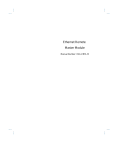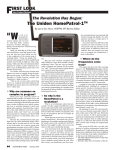Download Eton E1XM Specifications
Transcript
F IRST LOOK CONSUMER RADIOS AND ELECTRONICS A Radio Revolution – Eton E1XM By Larry Van Horn, N5FPW MT Assistant Editor T here is a radio revolution taking place and the leader of that revolt is a new entry into the shortwave portable market, the Eton E1XM. The E1XM, part of the new Eton Elite Series, is the world’s first radio to combine AM, FM, Shortwave, and XM Satellite Radio* technology into one unit. The E1XM offers reception through a digitally synthesized PLL tuner with a synchronous detector, passband tuning, and selectable bandwidth filters. Manufactured in India (not China) it has 1,700 station presets, and a robust memory scan function. But more importantly, and what sets this radio above any other portable in the marketplace today, is the plethora of features, level of performance, and inclusion of the XM satellite reception capability, all in one neat and trim package. ❖ Inside the Box The first thing I noticed when I took the E1XM out of the box was a sleek, well-built portable radio. Gone are the huge boom box and quality control issues of its predecessor, the Grundig Satellite 800. The case appears to be made of a type of hard plastic. The ergonomics are good, though some of the buttons on the front of the radio are a bit on the small side. Applying power and tuning around in the AM/FM bands, I was impressed with the excellent and clean audio. Tuning through both broadcast bands, I noted that signal levels were good (especially in the FM broadcast spectrum). The base and treble controls allowed for a wide range of adjustment to set the audio just right for the station being received. The use of selectable filters (2.3, 4.0 and 7.0 kHz) regardless of mode is something you don’t normally see on most portable radios and is a welcome feature. A DX soft key turns on a preamp to improve reception on weaker signals. As I dug deeper into the operation of the radio, I sensed the feel of a Drake design. A call to Walter Hess, the technical support manager at Eton, confirmed that Drake did have a major hand in the electronics of this unit. One of my chief complaints with many shortwave radios is their much-hyped “synchronous detection” feature. The E1XM has a selectable sync detector that actually works. In fact, it worked very well indeed. In the shadow 70 MONITORING TIMES November 2005 ❖ Antennas MT Rating: 3 3/4 Stars of nearby local stations, AM Sync allowed me to monitor weaker AM signals as close as 10 kHz away from the local station. Another nice surprise was the Pass Band Tuning (PBT) control. This is well implemented, with a numeric indication on the display of where the control setting is set. It also does its job very well. The AGC has a Slow/Fast and Auto mode which keep the AGC in fast mode while tuning so you don’t miss weak signals. Though it works well, I would have liked to see an additional setting of “off.” Single Sideband (SSB) reception is also good. And as an extra bonus, there is a feature in the radio’s menu system that allows you to enable or disable Enhanced SSB. When enabled, it adds another 30dB image rejection, which is a very nice feature. As I mentioned above, the E1XM has 1,700 memories that can be used to store and recall commonly monitored frequencies. The first 500 are called “memory” channels and the remaining 1,200 are referred to as “Country” channels. These 500 memory channels can be scanned using the “seek” function which can stop on any stored channel with a predetermined squelch level. The “Country” feature is used to enter all known signals from countries you listen to regularly. These country memories can be scanned using the T.SCAN function to selectively monitor desired “memory” channels. The following receiver controls and information can be stored in each memory channel: frequency, mode, bandwidth, AGC and PBT settings, and synchronous detector settings. You can choose from the internal antenna (whip) to an external antenna, using one of two slide switches on the side of the radio. One switch is for FM and one for HF (LW/MW/SW). The manual states that a PAL to female F adapter is included for external antenna connection. This was not the case in the initial shipment from Eton. Mr. Hess says anyone wanting the adapter can contact Eton and they will be supplied with one. But if you don’t want to wait on Eton for the adapter, you can pick one up from Radio Shack (#278-265B) or buy a cable from Universal Radio that has an F to SO-239 connector. And one final antenna note: this radio does not have a built-in ferrite loop antenna for LW/AM broadcast reception. According to Mr. Hess, the display was generating a lot of noise and they decided not to incorporate an internal antenna for those bands. Instead, you will be using the whip antenna or an external antenna (not included) if you want improved reception in those bands. ❖ The Display Speaking of the display, it is a dot matrix type (which might explain the noise issue noted above), and it is nice, big and clear. You can adjust the brightness and contrast, or turn it off completely. You can choose between off, dim, medium or bright, using a multi-purpose switch on top of the unit. The display defaults to dim when turned off or you can turn it off completely when the AC adapter is used. With batteries, the display will turn itself off to save energy. And when it is off, it will display either the local or UTC time (if set). ❖ XM Radio XM Radio is a subscription service, and MT First Look Rating (0-10 scale) Audio Quality...................................... 8 Audio Levels........................................ 8 Back light/Display ............................... 5 Battery Life .......................................... 7 Ease of use ......................................... 7 Feature Set ......................................... 8 Keyboard/Button/Control Layout ......... 7 Overall Construction ........................... 8 Overall Reception ................................ 7 Overall Manual ................................... 6 therefore is not free. But this radio is XM capable and all that is needed is to pay the activation and monthly subscription fees, buy the optional $50 XM antenna/module, and you are in business. Once you open up the world of XM satellite there are a lot of neat services, and the feature does add a lot of additional value to the listening capability of this radio. Music, news, and sporting events (including all Major League Baseball games) are some of the many services on XM. For more information on this, see John Figliozzi’s Programming Spotlight column in the October 2005 issue of Monitoring Times. ❖ Overall Rating and Final Thoughts Overall, I like the E1XM. As I mentioned previously, this is a major improvement over the now discontinued Grundig Satellite 800. But as is the case with most radios, there is room for improvement. I was disappointed by the lack of DRM capability. Given the push by major shortwave broadcasters toward DRM, I felt Eton missed a golden opportunity by not including this mode in their flagship radio. I would gladly pay extra to have the DRM mode in the E1XM. No carrying handle. Yes, this is a moderately large portable without a carrying handle. Also, the adjustable stand (adjustable to one position at 45 degrees) is disappointing. They used a soft plastic for the stand and we noted during our testing time that it tended to bend. Bottom line – don’t lean too hard on the radio when you are steadying your hand on it while tuning around. We pointed this out to Eton and it has been relayed to the engineers. We did note something very strange during our test. The external antenna adapter got warm. In fact, it got very warm. So much so, we contacted Eton immediately and they also verified the problem. It isn’t anything that will harm you, but I have to wonder how long it will be before that heat loosens up the external antenna jack in the unit. The backlight display is entirely too dim. Even with lights turned out and the contrast at maximum, it is too faint. You will really notice this when you place the unit in ambient light and are using the adjustable stand. Probably my biggest beef with the E1XM is that it uses double instead of triple conversion. We didn’t see a lot of resulting problems here in Brasstown, but I am not sure that will be the case for other end users in more robust RF environments. The Exalted Carrier Single Sideband (ECSS) seemed a tad off. I have seen at least two more reports that back up what we saw in our test unit (serial number 00528). It isn’t extreme, but to an old AM broadcast band DX hound like me, it is noticeable enough. Finally, while most of the manual is well written, the Appendix gets an “F.” It is loaded with errors, wrong frequencies and much more. We sent Eton several pages of changes and they promised that they would be included in future editions of the manual. Overall, we are very pleased to see Eton introduce a quality product such as the E1XM. It now becomes the benchmark which we will use to judge other radios following in its footsteps. With the release of the Eton Elite, a radio revolution has truly begun and the E1XM is the leader. *The E1 comes equipped with XM’s connect and play technology. An optional satellite antenna (VX300 $49.85), activation fee, and a monthly subscription are required to listen to XM Satellite radio. The E1XM is available from Grove Enterprises, Inc. for $499.95 plus shipping. MANUFACTURER SPECIFICATIONS Frequency Range: Band Mode(s) Frequency Ranges Longwave AM, LSB, USB 100 - 500 kHz Mediumwave AM, LSB, USB 500 - 1800 kHz Shortwave AM, LSB, USB 1800 - 30,000 kHz FM Broadcast FM 76 - 108 MHz (range is selectable: 76 - 90 MHz or 87 - 108 MHz) XM Digital Digital 2.3325 - 2.3450 GHz (Optional) Sensitivity: SSB (10 dB S+N/N) Less than .25 µV 0.1 - 30 MHz (DX on) Less than .5 µV 0.1 - 30 MHz (Normal) Sensitivity: AM (10 dB S+N/N, 1000 Hz, 30% modulation) Less than 2.0 µV 0.1 - 30 MHz (DX on) Less than 4.0 µV 0.1 - 30 MHz (Normal) 3 Watts normal - operation from AC adapter. Internal Speaker: 4 inch (10.16 cm) 8 ohms Line Audio Output: 300 mV, 47k ohms Line Audio Input Jack: 1/8 inch (3.175 mm) stereo Headphone Jack: 1/8 inch (3.175 mm) stereo Sensitivity: FM (20 dB S/N, monaural) Less than 1.5 µV 76 - 108 MHz (DX on) Less than 4 µV 76 -108 MHz (Normal) DC Power Requirements: Input 7-14 VDC supplied from AC adapter, external DC power supply or 3.6 to 6.0 VDC supplied by four internally mounted “D” cell (1.5VDC) batteries (not supplied). Frequency Resolution: 10 Hz in AM and SSB modes, 20 KHz in FM mode Frequency Stability: ± 10 ppm, 0° to 50°C Frequency Accuracy: Better than ± 100 Hz at 25°C AC Power Requirements: 120 VAC ±10% to 9 VDC, 15 Watt 1 Amp AC adapter. Center conductor of connector is positive, negative is connected to input ground. Selectivity (AM and SSB): 7 kHz at -6 dB, less than 12 kHz at -60 dB 4 kHz at -6 dB, less than 9 kHz at -60 dB 2.3 kHz at -6 dB, less than 5 kHz at -60 dB Current requirements (approximate) from 9.0 VDC supply Worse case at maximum volume: 850 mA nominal with backlight display off and 900 mA with it on. From batteries with 1/4 watt average audio output (normal battery currents): FM mode – 175 mA backlight off, 225 mA backlight on. LW/MW/SW – 210 mA backlight off, 260 mA backlight on. XM – 350 mA backlight off, 400 mA backlight on. IF Frequency: 1st IF 45.0 MHz (AM and SSB) 2nd IF 455 kHz (AM and SSB) 1st IF 10.7 MHz (FM) Image Rejection: Greater than 70 dB, 0.1 - 30 MHz Greater than 55 dB, 76 - 108 MHz IF Rejection: Greater than 80 dB, 45.0 MHz Greater than 80 dB, 455 kHz IP3 - Intercept Point 50 ohm antenna input): Greater than +10 dBm at 20 kHz spacing (Normal) Greater than -20 dBm at 5 kHz spacing (Normal) -30 dBm at 5 kHz spacing (DX) AGC Performance: Threshold: 1.0 V Attack Time: 1 msec (Bandwidth dependent) Release Time: Slow 3 seconds, Fast 300 msec Less than 2 dB change in audio output for 90 dB. RF input change referenced from the AGC threshold point plus 3 dB. Internal Antenna: 30 1/4 inch (1.003 meters) telescopic antenna (for use on all bands). External Antenna: 50 to 75 ohm, PAL type male (PAL to F type adapter included) External Speaker Output: 4 to 8 ohms, external jack is 1/8 inch (3.175 mm) Audio Power (internal or external speakers): 1.25 Watts - battery operation Operating Temperature: 0° to 50°C Shipping Weight: 6 lbs (2.72 kg) (includes AC adapter, batteries not included) Size: 13-1/8 inch width (33.37 cm) by 7-1/2 inch height (19.05 cm) by 2-9/16 inch depth (6.5 cm) Note: Published specs subject to change SIGNAL STRENGTH METER < 3 MHz to > 5 GHz The ZC 185 is an extremely sensitive MODEL Radio Frequency Detector operating over ZC 185 a broad range of frequencies. HAM RADIO: Detects and locates Fox Xmtrs, far-field tune-ups of milliwatt to kilowatt rigs, measures antenna patterns, detects oscillations, locates cable leaks and RFI, monitors power levels. COMPUTER WIRELESS: Super Wi Fi Sniffer, detects Hot & Cold spots, measures baseline RF, optimizes hub & satellite network sites, locates hacker sites, strengthens RF-signal links. $159.00 (+$7 S&H) SECURITY: Supersensitive covert camera and bug detector, simplifies wireless installations, aligns antennas, verifies transmissions, identifies hacker sites, locates interference. WWW.ZAPCHECKER.COM ALAN BROADBAND CO Ph: (650) 369-9627, Fax: (650) 369-3788 November 2005 MONITORING TIMES 71









